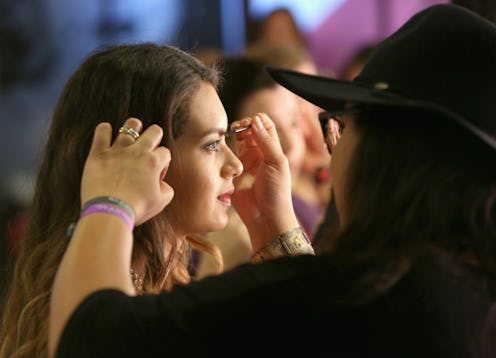Fashion
5 Ways To Have Better Tweezing Habits
We’ve all had our fair share of unforgettable brow horror stories, but how often do we ask ourselves if tweezing is good for us or not? What we don’t really realize is that overindulging in some of our everyday brow rituals (things like tweezing and trimming) can contribute negatively to our brows.
Take the daily art of tweezing, for example. Sure, an occasional pluck here or there won’t completely wreck your brows, but often at times, just one tweeze can lead to a 20-minute grooming session, leading to overdone looking brows in return. If that's your ideal look, then that's great, but if it's not your goal, there are some things to know about your tweezing habit.
“Tweezing at home usually results in an attempt at a dramatic arch which means that the person just removed too much hair,” says Melanie Gilliland European Wax Center’s Chief Wax Expert and Educator in an interview with Bustle. “Guests can usually tweeze a stray hair here and there, but should definitely avoid any attempts at shaping or removing too many hairs.”
While tweezing isn’t exactly the best brow solution, you don’t have to necessarily throw out your tweezers altogether. Simply understanding better (and safer!) tweezing habits can help avoid a horrid misshaped arch. To still master that full and sexy arch without any serious damage, here’s how to get better brows, without any embarrassing shapes or shame in between.
1. Don't Pluck Too Much
While tweezing is fast and convenient way of removing hair, over plucking your brows can really do a number on the brow’s follicle growth, causing brow hairs to grow back thinner, explains Romy Soleimani, Beauty Director at Large at Beauty.com in an interview with Bustle.
“There are certain precautions to take when tweezing eyebrows,” explains Solemani. “For starters, you want to make sure you aren't over-plucking, which can stunt follicle growth, causing hair to grow back much thinner or not at all.”
2. Have Safer Habits
Sure, tweezers can cause damage if you aren’t careful, but to ensure better hair removal, experts like Soleimani recommend using sanitized tools each time you shape your brows.
“Tweezing, waxing, threading can be safe if the tools are sanitized,” says Soleimani. “It's important that tweezers are sanitized so that bacteria can't enter into the follicle and cause ingrown hairs.”
3. Resist The Urge To Over Tweeze
While using sanitized tools can definitely make a difference, practicing the habit of tweezing less can also keep brows in good shape. When tweezing on occasion though, be sure to keep your look natural, and touch up every one to three weeks, suggests Soleimani.
“Only pluck stray hairs as needed,” she says. “Touch up every one to three weeks, depending on the rate of your hair growth. If you have any sparse areas, fill them in with an eyebrow pencil or powder in the same shade or one shade lighter than your brow color.”
4. Seek Out An Expert
If you are a bit weary of making big brow blunders, seeking the help of a professional is a helpful approach anyone can take. Trained professionals have skills that can help create a more subtle (yet still noticeable) look free of any damage or humiliation.
“In doing brows themselves, guests can remove way too much hair leaving the brows too thin and still not perfectly symmetrical,” suggests brow expert Melanie Gilliland. “One hair can make a big difference in brow shape and without experience in brows, you will end up removing hairs that are crucial to the shape and leaving hairs that could be removed.”
5. Ask Yourself If You Should You Continue To Tweeze
While tweezing is easy and effective, it can be harmful to your brows if you aren’t careful. But instead of tossing your tweezers in the trash, be sure to use sanitizing tools, and pluck stray hairs on occasion. However, if thin and uneven brows are something you just can’t handle, always seek the help of a professional, as they are trained to ensure you a clean and strong arch.
See? Tweezing isn't all bad with a little self-control and professional help here and there.
Images: Karen/Flickr, Giphy (4)
